Full Surface Heat Transfer Characteristics of Stator Ventilation Duct of a Turbine Generator
Abstract
1. Introduction
2. Experimental and Computation Approaches
2.1. Experimental Model and Approach
2.2. Computational Approach
3. Results
3.1. Detailed Flow Filed Analysis
3.2. Local Static Pressure Distribution
3.3. Overall Frictional Loss (Exclude Entrance Effect)
3.4. Heat Transfer Characteristics
3.5. Overall Area Averaged Heat Transfer
4. Conclusions
Author Contributions
Funding
Conflicts of Interest
References
- Zhou, G.-H.; Han, L.; Fan, Z.-N.; Zhang, H.-B.; Dong, X.-C.; Wang, J.; Sun, Z. Ventilation Cooling Design for a Novel 350-MW Air-Cooled Turbo Generator. IEEE Access 2018, 6, 62184–62192. [Google Scholar] [CrossRef]
- Fechheimer, C.J. Turbine Generator Ventilation. J. Frankl. Inst. 1933, 216, 505–532. [Google Scholar] [CrossRef]
- Han, J.D.; Hong, G.Y.; Tang, L.; Lu, Y.P. Numerical Studies on the Flow Field of Stator and Air Gap for Large Air-Cooled Turbo-Generator. In Advanced Materials Research; Trans Tech Publications Ltd.: Stafa-Zurich, Switzerland, 2012; Volume 516, pp. 970–975. [Google Scholar]
- Yoo, W.; Jeon, S.; Son, C.; Yang, J.; Ahn, D.; Kim, S.; Hwang, K.; Ha, S. Full Surface Heat Transfer Characteristics of Rotor Ventilation Duct of a Turbine Generator. Appl. Therm. Eng. 2016, 94, 385–394. [Google Scholar] [CrossRef]
- Tang, L.; Lu, Y.P.; Deng, H.Y.; Wang, Z.M. Research of Flow Field and Temperature Field in 2D Annular Space of Air-Gap. In Applied Mechanics and Materials; Trans Tech Publications Ltd.: Stafa-Zurich, Switzerland, 2012; Volume 214, pp. 76–81. [Google Scholar]
- Mayle, R.E.; Hess, S.; Hirsch, C.; Van Wolfersdorf, J. Rotor-Stator Gap Flow Analysis and Experiments. IEEE Trans. Energy Convers. 1998, 13, 101–110. [Google Scholar] [CrossRef]
- Tong, W. Numerical Analysis of Flow Field in Generator End-Winding Region. Int. J. Rotat. Mach. 2008, 2008, 692748. [Google Scholar] [CrossRef]
- Klomberg, S.; Farnleitner, E.; Kastner, G.; Bíró, O. Characteristics of the Convective Heat Transfer Coefficient at the End Winding of a Hydro Generator. J. Therm. Sci. Eng. Appl. 2015, 7, 011011. [Google Scholar] [CrossRef]
- Klomberg, S. Numerical Study of the Cooling Air Flow in a Hydro Generator with Various Ventilation Systems. In Proceedings of the European Conference on Computational Fluid Dynamics, Barcelona, Spain, 20–25 July 2014. [Google Scholar]
- Carew, N.J.; Freeston, D.H. Paper 12: Fluid Flow Losses in AC Generator Stator Ventilating Ducts. In Proceedings of the Institution of Mechanical Engineers, Conference Proceedings; SAGE Publications Sage UK: London, UK, 1967; Volume 182, pp. 87–95. [Google Scholar]
- Ding, S.; Liu, H.; Sun, Z.; Ge, Y. Notice of Retraction: Research of Fluid Flow Characteristic inside Radial Ventilation Duct for Large Generator. In Proceedings of the 2010 Asia-Pacific Power and Energy Engineering Conference, Chengdu, China, 28–31 March 2010; IEEE: Piscataway, NJ, USA, 2010; pp. 1–4. [Google Scholar]
- Hribernik, A.; Fike, M.; Gregorc, B. Investigating the Malfunction of a Hydrogenerator’s Cooling-System. In Proceedings of the TMT 2011 15th International Research/Expert Conference” Trends in the Development of Machinery and Associated Technology, Prague, Czech Republic, 12–18 September 2011; pp. 861–864. [Google Scholar]
- Gunabushanam, N.; Suresh, J. Experimental and CFD Analysis of Hydrogenerator Ventilation Components. Proc. CIGRE Sess. 2006. [Google Scholar]
- Pasha, A.A.; Hussain, M.; Gunubushanam, N. Experimental and CFD Analysis of Hydrogenerator Stator. In Proceedings of the 37th National and 4th National Conference on Fluid Mechanics and Fluid Power, IIT Madras, Chennai, India, 16–18 December 2010. [Google Scholar]
- Chella, R.G.; Govinda, R.K.; Gunabushanarn, N. Design and Analysis of Hydro Generator Ventilation System Using Experimental and CFD. In Proceedings of the World Academy of Science, Engineering and Technology, Paris, France, 14–16 November 2011; Volume 75, pp. 277–280. [Google Scholar]
- Schrittwieser, M.; Marn, A.; Farnleitner, E.; Kastner, G. Numerical Analysis of Heat Transfer and Flow of Stator Duct Models. IEEE Trans. Ind. Appl. 2013, 50, 226–233. [Google Scholar] [CrossRef]
- Li, Y.; Li, W.; Su, Y. Sensitivity of Axial Velocity at the Air Gap Entrance to Flow Rate Distribution at Stator Radial Ventilation Ducts of Air-Cooled Turbo-Generator with Single-Channel Ventilation. Energies 2019, 12, 3442. [Google Scholar] [CrossRef]
- Liang, Y.; Bian, X. Influence of Stator Ventilation Channel Cutting Length on the Multi-Physics in Air-Cooled Hydro-Generator. In Proceedings of the 2012 Sixth International Conference on Electromagnetic Field Problems and Applications, Dalian, Liaoning, China, 19–21 June 2012; IEEE: Piscataway, NJ, USA, 2012; pp. 1–4. [Google Scholar]
- Wang, J.; Li, G.Q.; Xu, G.J.; Li, H.B.; Yuan, X. Structural Optimization for Stator Radial Ventilation Cooling System of Turbo Generator. In Advanced Materials Research; Trans Tech Publications Ltd.: Stafa-Zurich, Switzerland, 2014; Volume 1039, pp. 65–68. [Google Scholar]
- Zhao, X.; Fan, Y.; Li, W.; Li, D.; Cao, J.; Zhang, Y. Optimization of Ventilation Spacer for Direct-Drive Permanent Magnet Wind Generator. Energies 2019, 12, 1430. [Google Scholar] [CrossRef]
- Xiong, B.; Gu, G.B.; Ruan, L.; Li, Z.G.; Fu, D.P.; Cao, R.; Guo, S.Q.; Gao, J.S. Studies on the Structure of Radial Ventilation Channel to Improve the Cooling Capacity of Large Turbo Generator Stator. In Proceedings of the 2014 17th International Conference on Electrical Machines and Systems (ICEMS), Hangzhou, China, 22–25 October 2014; IEEE: Piscataway, NJ, USA, 2014; pp. 354–357. [Google Scholar]
- Fan, X.; Qu, R.; Li, J.; Li, D.; Zhang, B.; Wang, C. Ventilation and Thermal Improvement of Radial Forced Air-Cooled FSCW Permanent Magnet Synchronous Wind Generators. IEEE Trans. Ind. Appl. 2017, 53, 3447–3456. [Google Scholar] [CrossRef]
- Liu, Y.; Li, C.; Fu, G.; Gao, S.; Tian, Y.; Zhai, Y. Study of Three-Dimensional Temperature Field with Changed Structures of Air-Cooled Turbo Generator Stator. Int. J. Control Autom. 2015, 8, 37–42. [Google Scholar] [CrossRef]
- Ujiie, R.; Arlitt, R.; Etoh, H. Application of Computational Fluid Dynamics (CFD) on Ventilation-Cooling Optimization of Electrical Machines. Rev. Energy Technol.-Gener. Transm. Distrib. Electr. Therm. Energy (Icemenerg) 2006, 4, 17–22. [Google Scholar]
- Gillespie, D.R. Intricate Internal Cooling Systems for Gas Turbine Blading. Ph.D. Thesis, University of Oxford, Oxford, UK, 1998. [Google Scholar]
- STANDARD, B.; ISO, B. Part 2: Orifice Plates; ISO: Switzerland, 2003. [Google Scholar]
- Jeon, S. A Study on the Cooling Performance of a Turbine Generator Stator Ventilation Duct System. Master’s Thesis, Pusan National University, Busan, South Korea, 2015. [Google Scholar]
- Schultz, D.L.; Jones, T.V. Heat-Transfer Measurements in Short-Duration Hypersonic Facilities; Advisory Group for Aerospace Research and Development: Paris, France, 1973. [Google Scholar]
- Ireland, P.T.; Wang, Z.; Jones, T.V. Measurement Techniques: Liquid Crystal Heat Transfer Measurements. Von Karman Inst. Fluid Dyn. Lect. Ser. 1995, 1, 1–67. [Google Scholar]
- Kline, S.J. Describing Uncertainty in Single Sample Experiments. Mech. Eng. 1953, 75, 3–8. [Google Scholar]
- Moffat, R.J. Describing the Uncertainties in Experimental Results. Exp. Therm. Fluid Sci. 1988, 1, 3–17. [Google Scholar] [CrossRef]
- Blasius, H. Das Aehnlichkeitsgesetz Bei Reibungsvorgängen in Flüssigkeiten. In Mitteilungen über Forschungsarbeiten auf dem Gebiete des Ingenieurwesens; Springer: Berlin/Heidelberg, Germany, 1913; pp. 1–41. [Google Scholar]
- Dittus, F.W.; Boelter, L.M.K. Heat Transfer in Automobile Radiators of the Tubular Type. Int. Commun. Heat Mass Transf. 1985, 12, 3–22. [Google Scholar] [CrossRef]
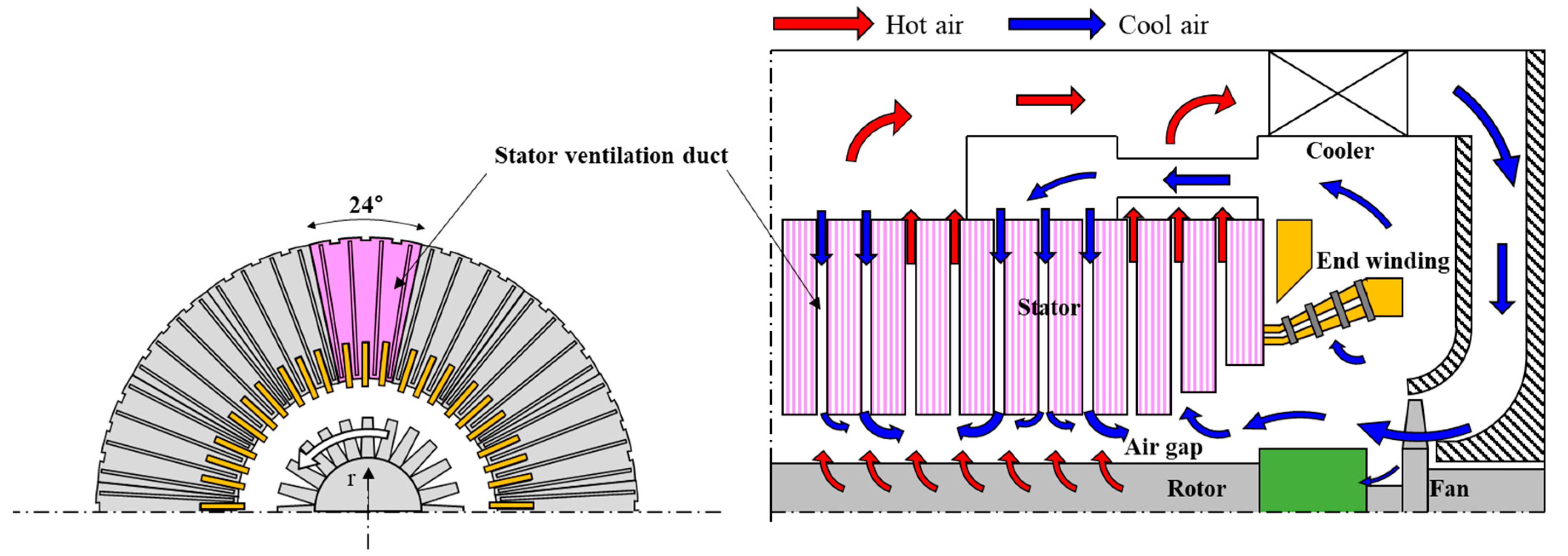
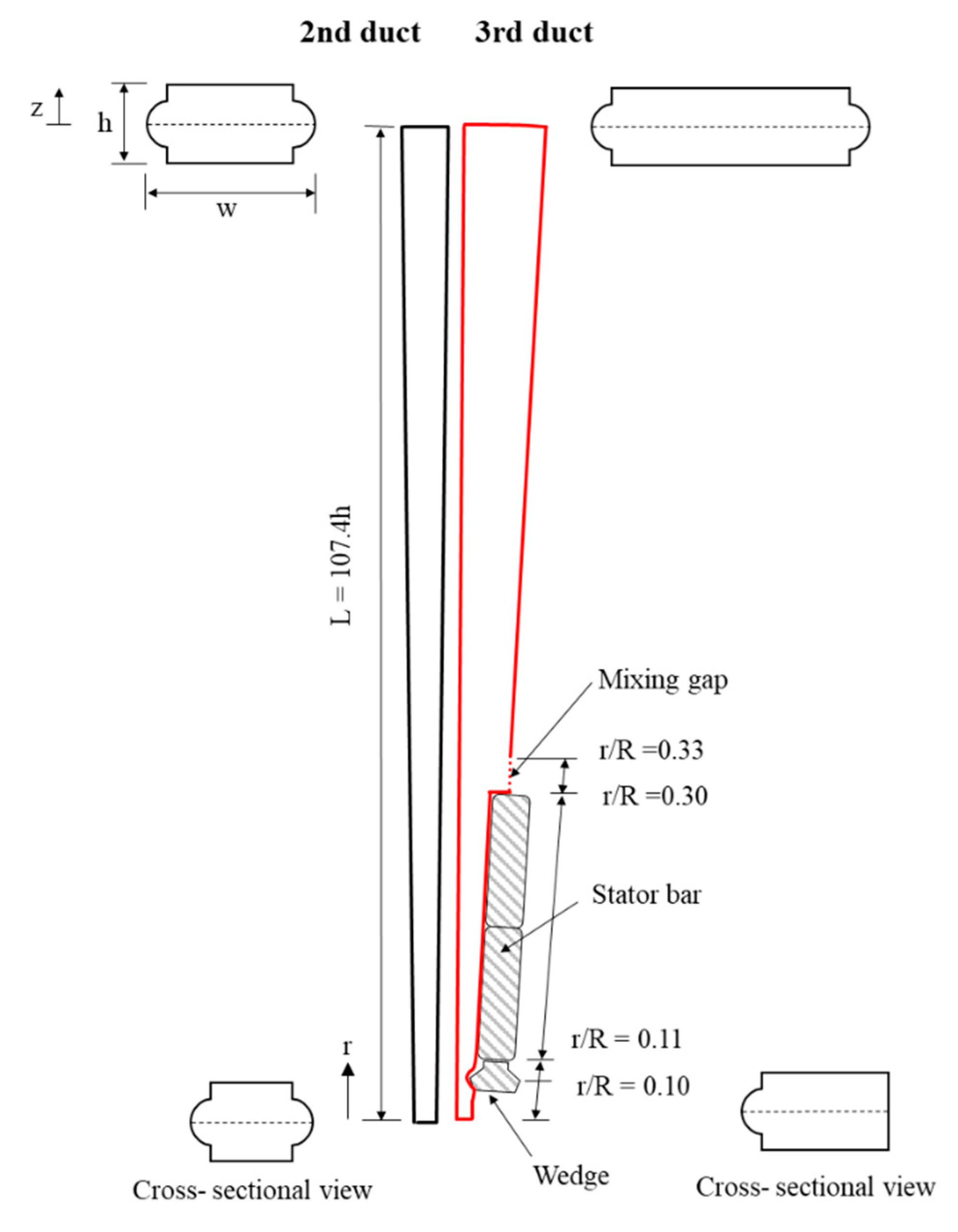
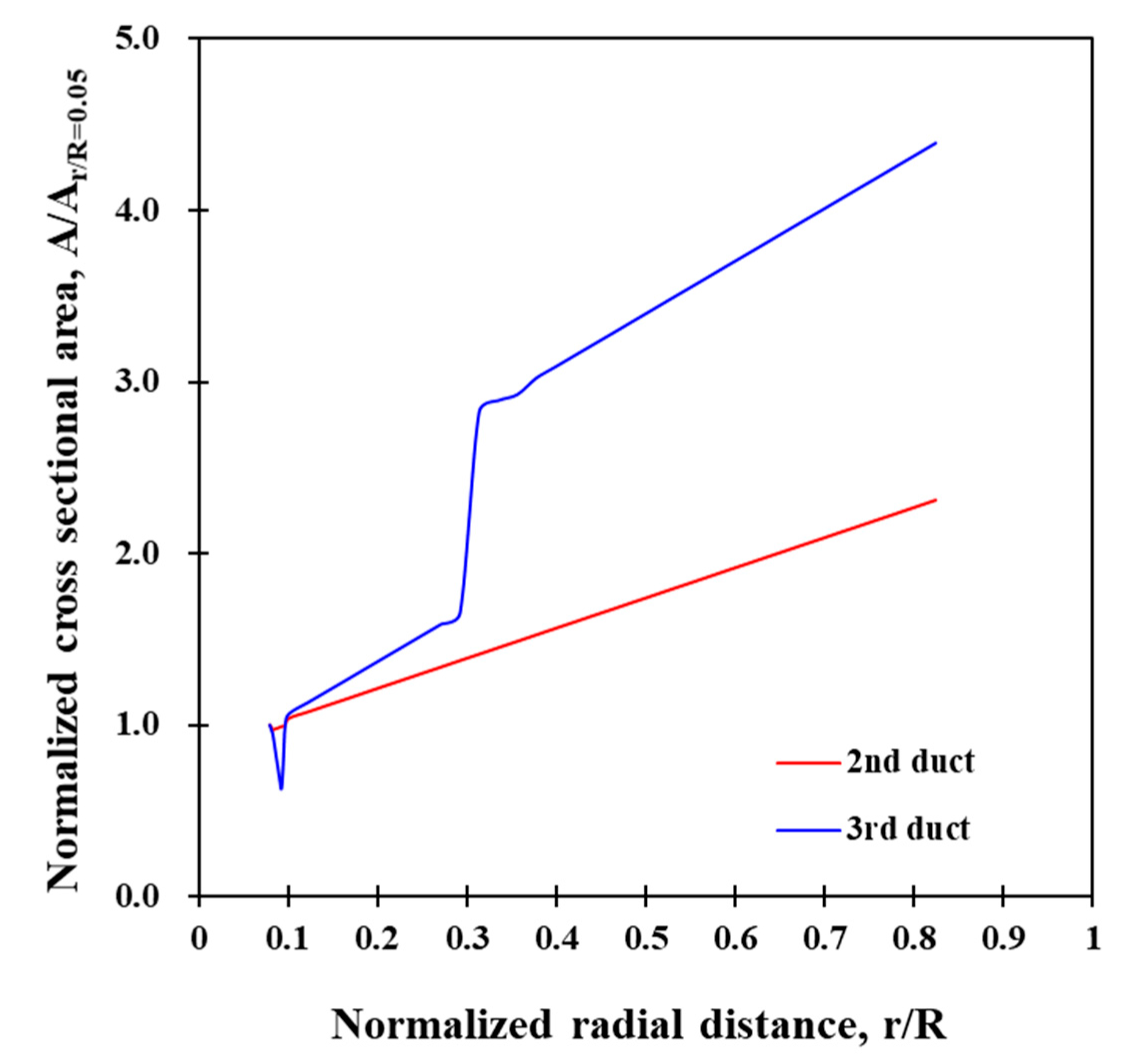
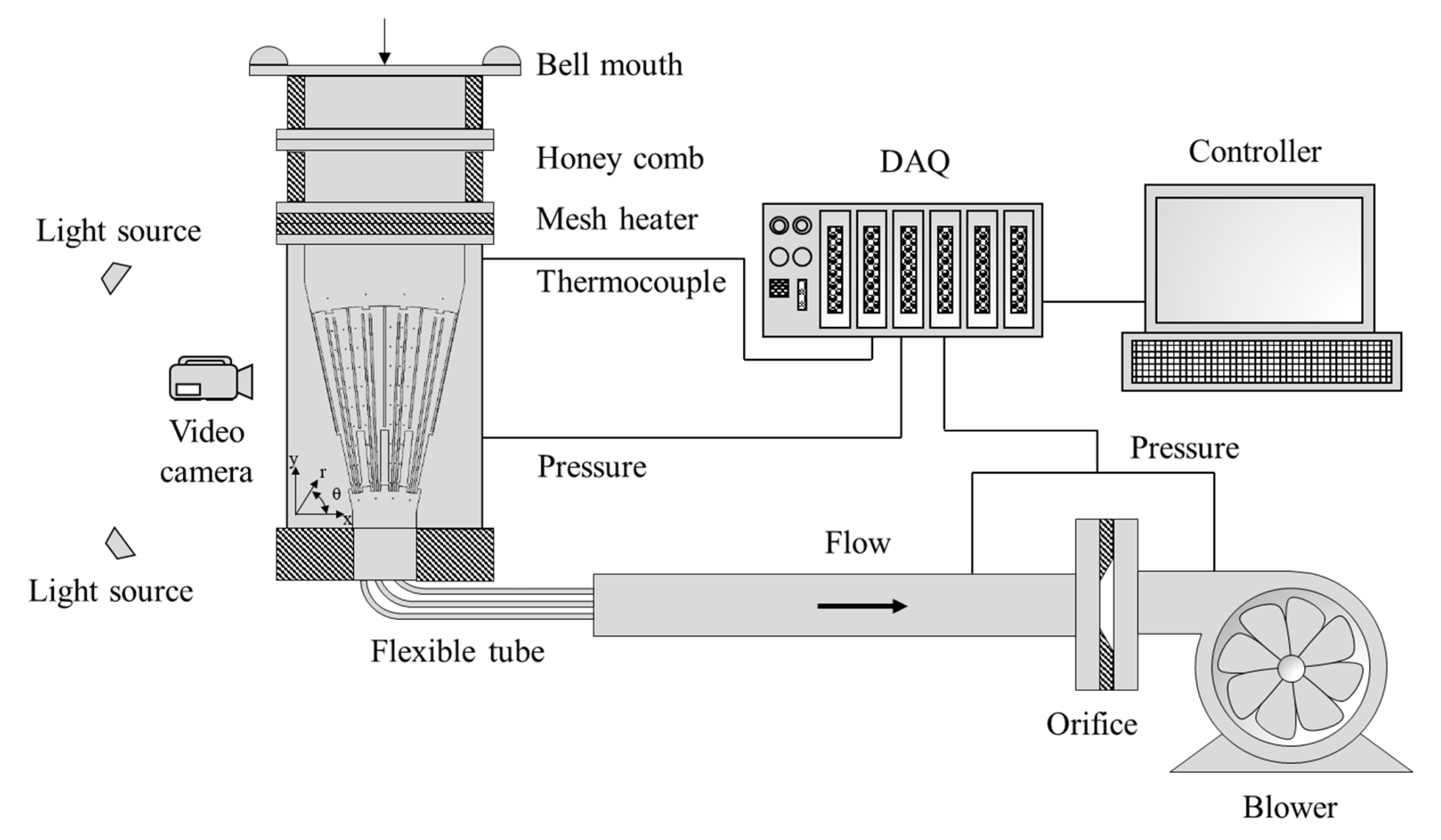

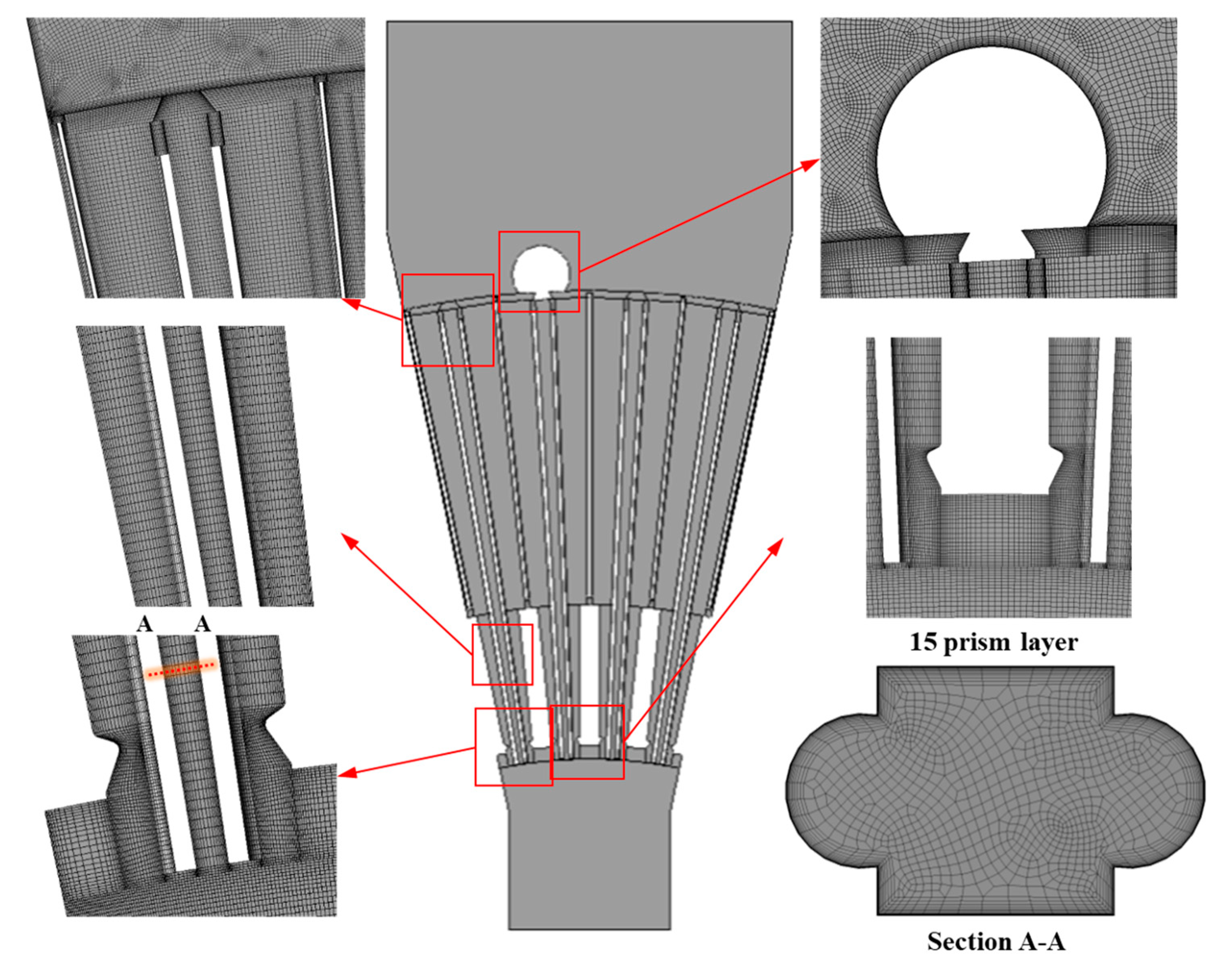
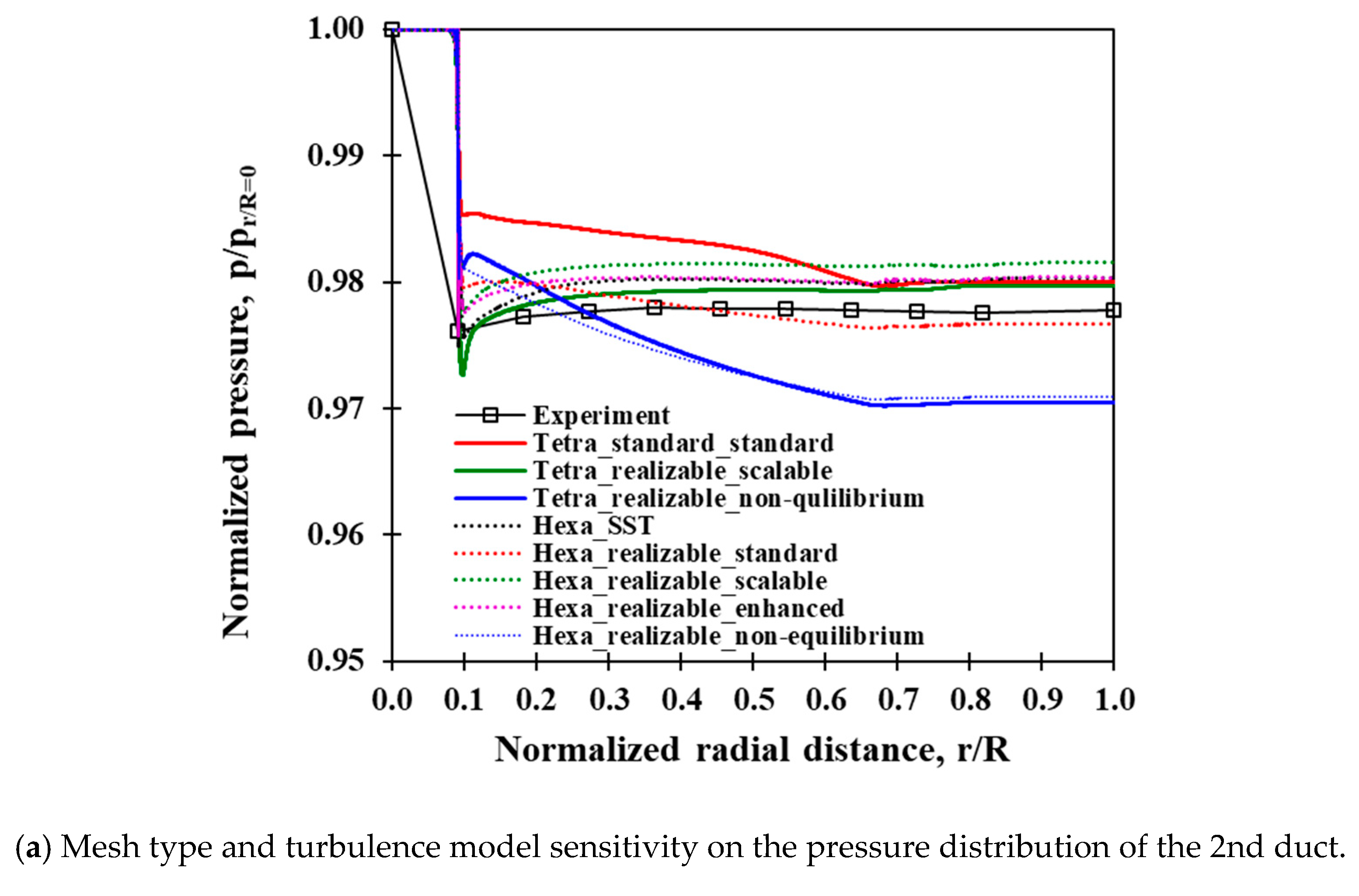
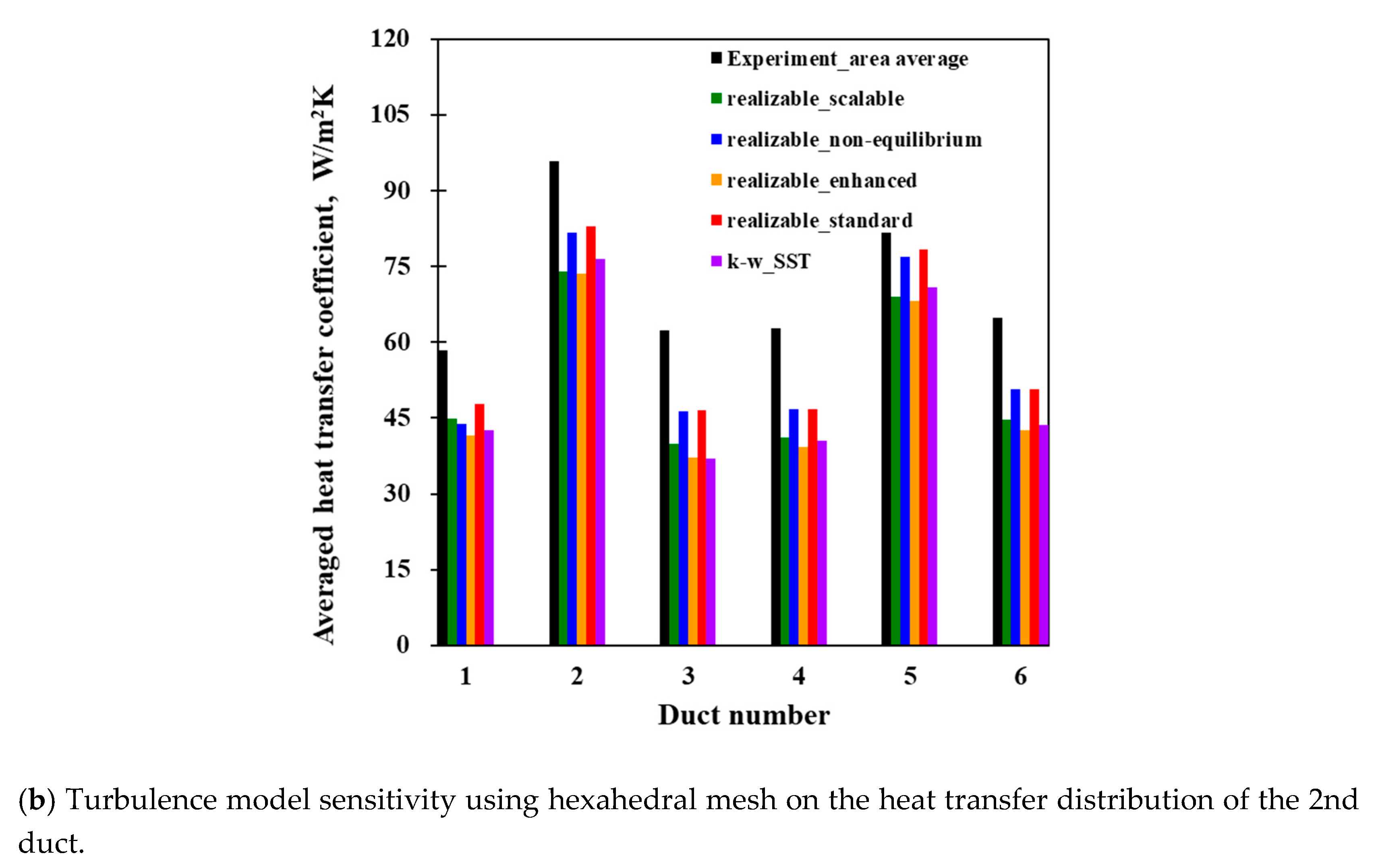
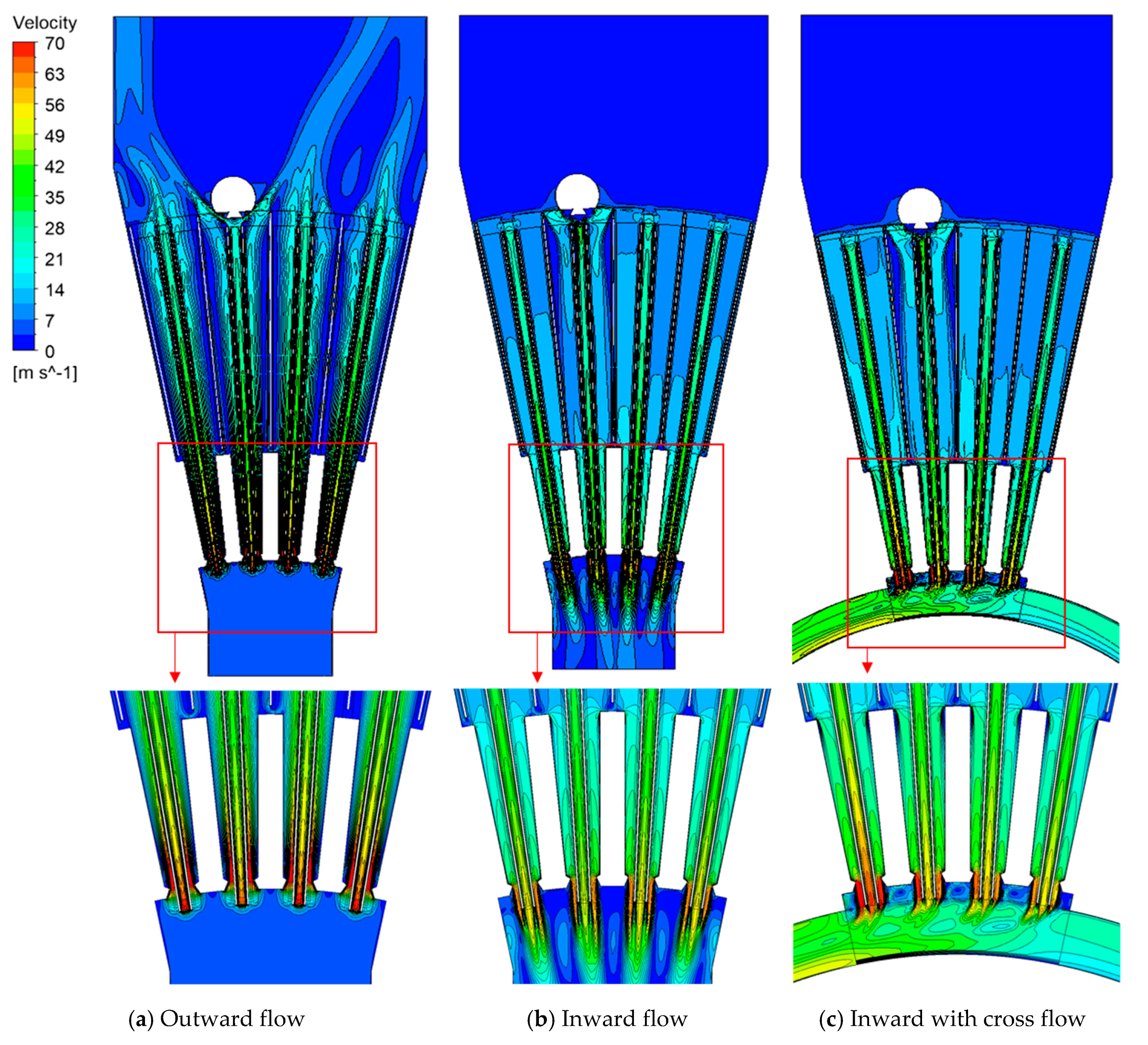
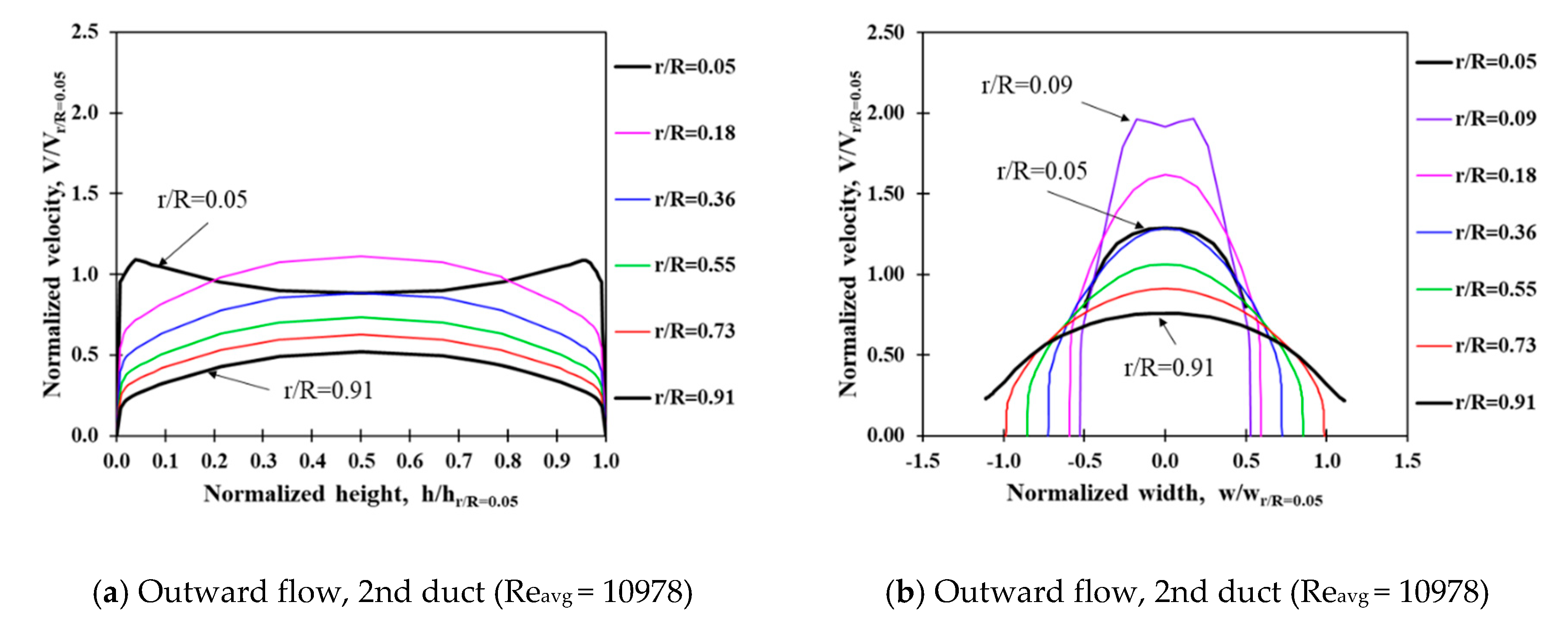
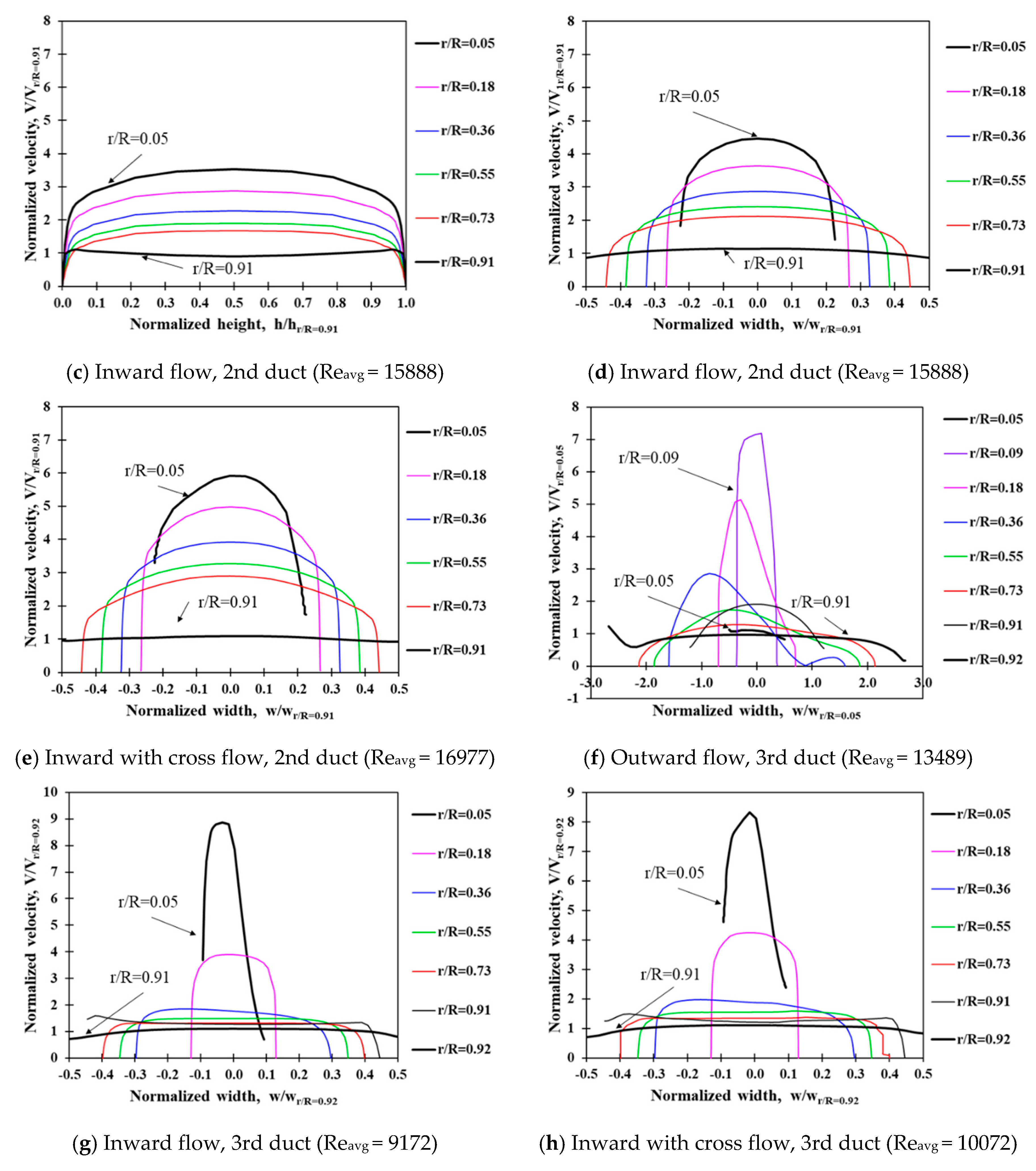

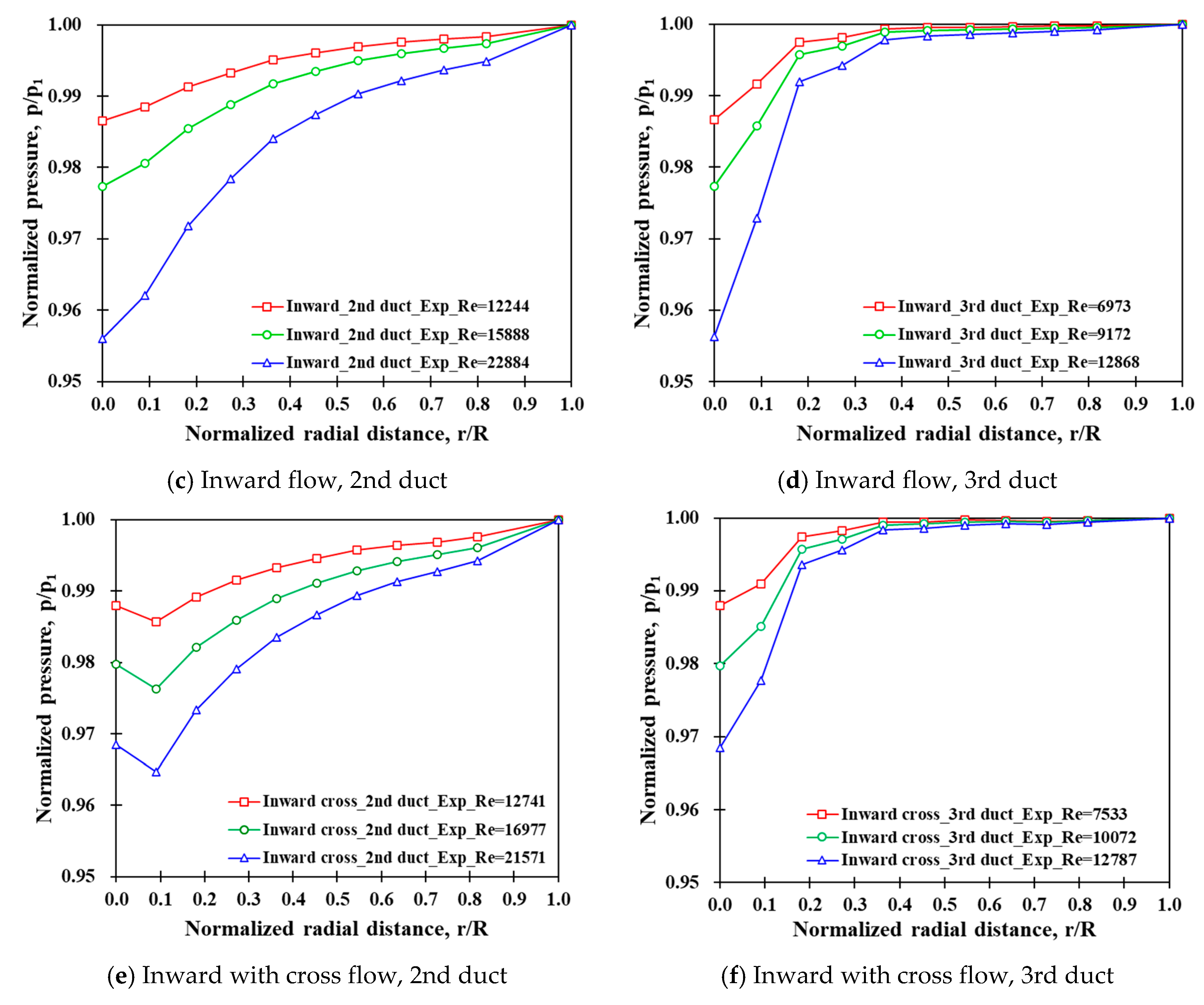
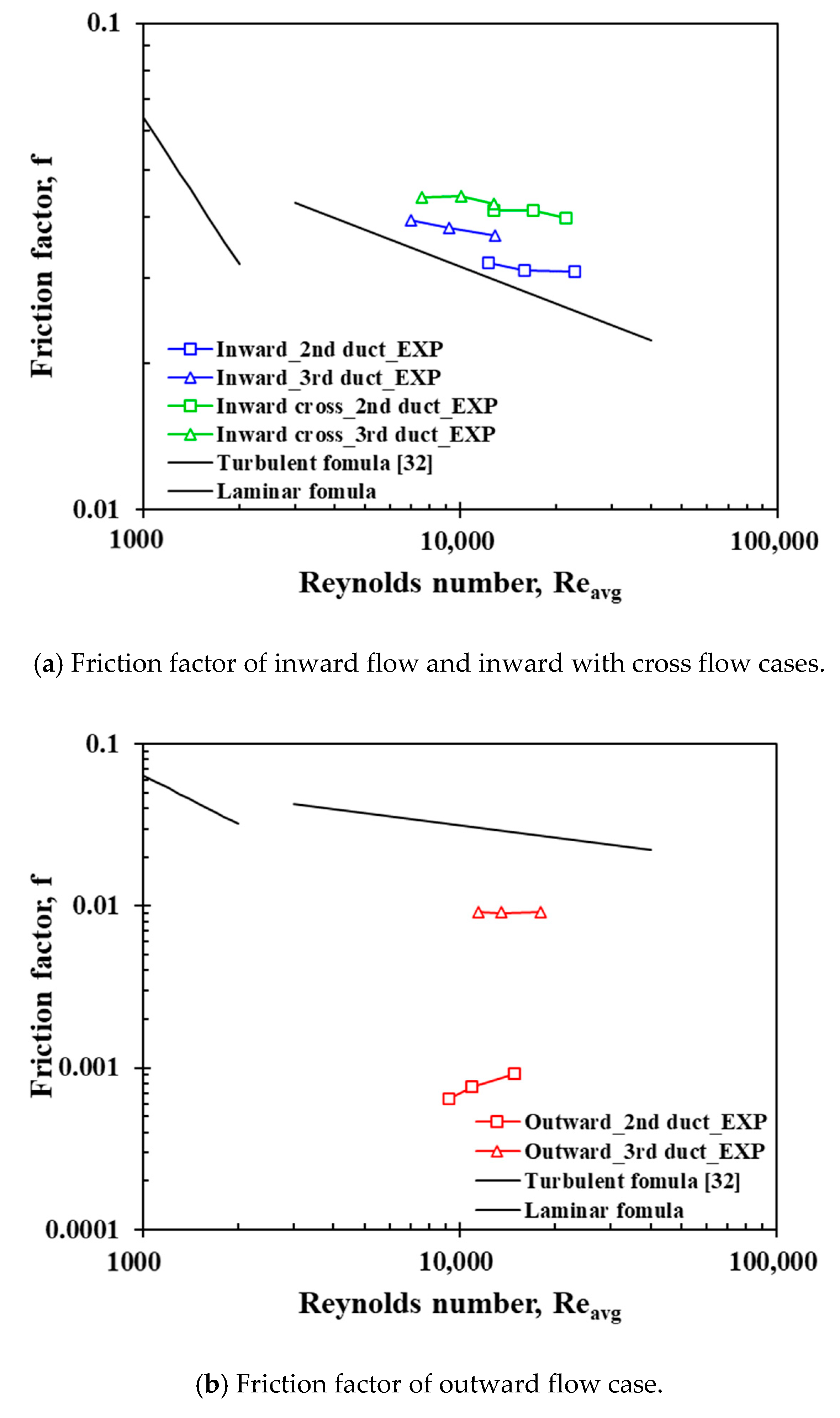
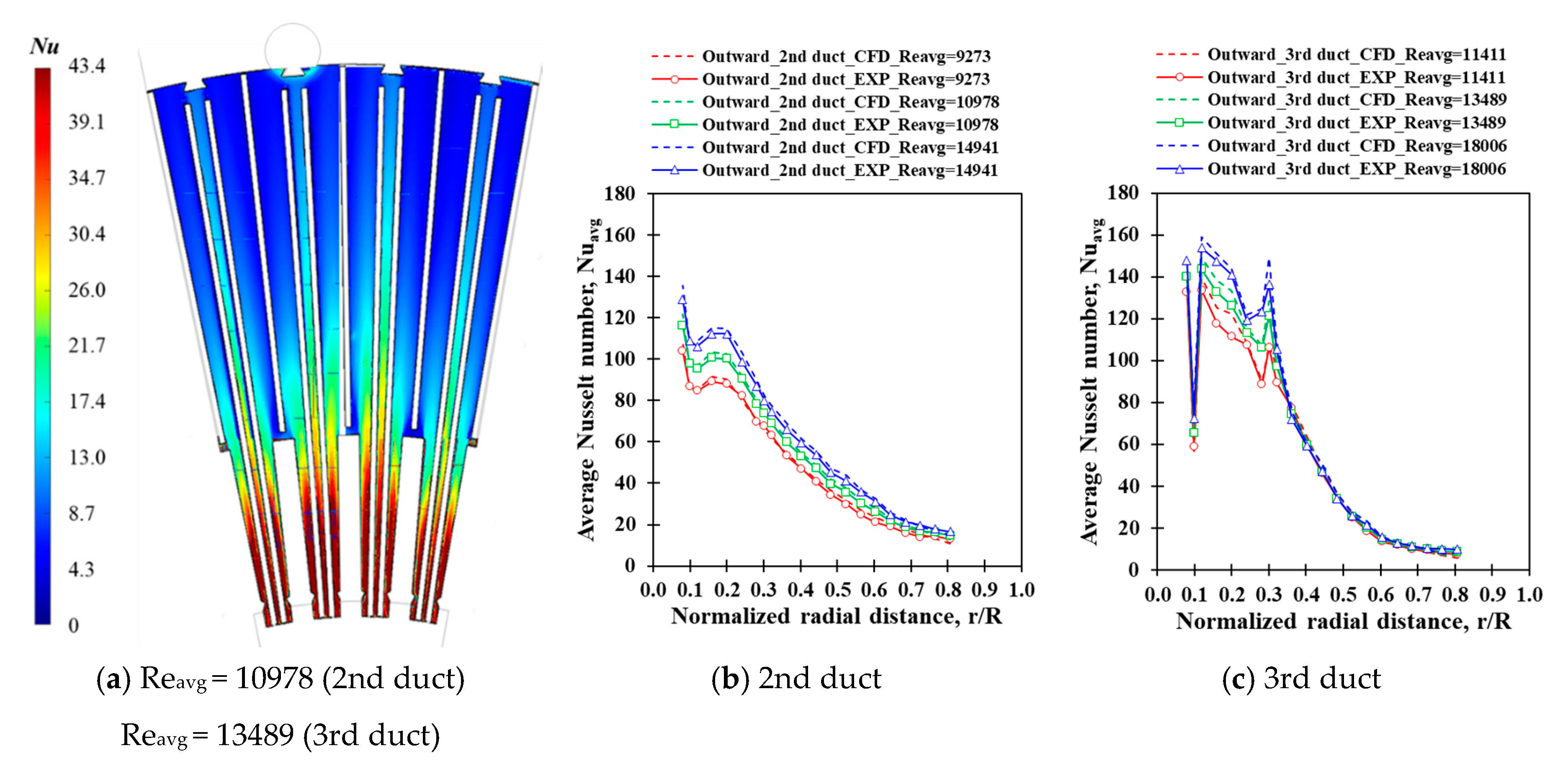
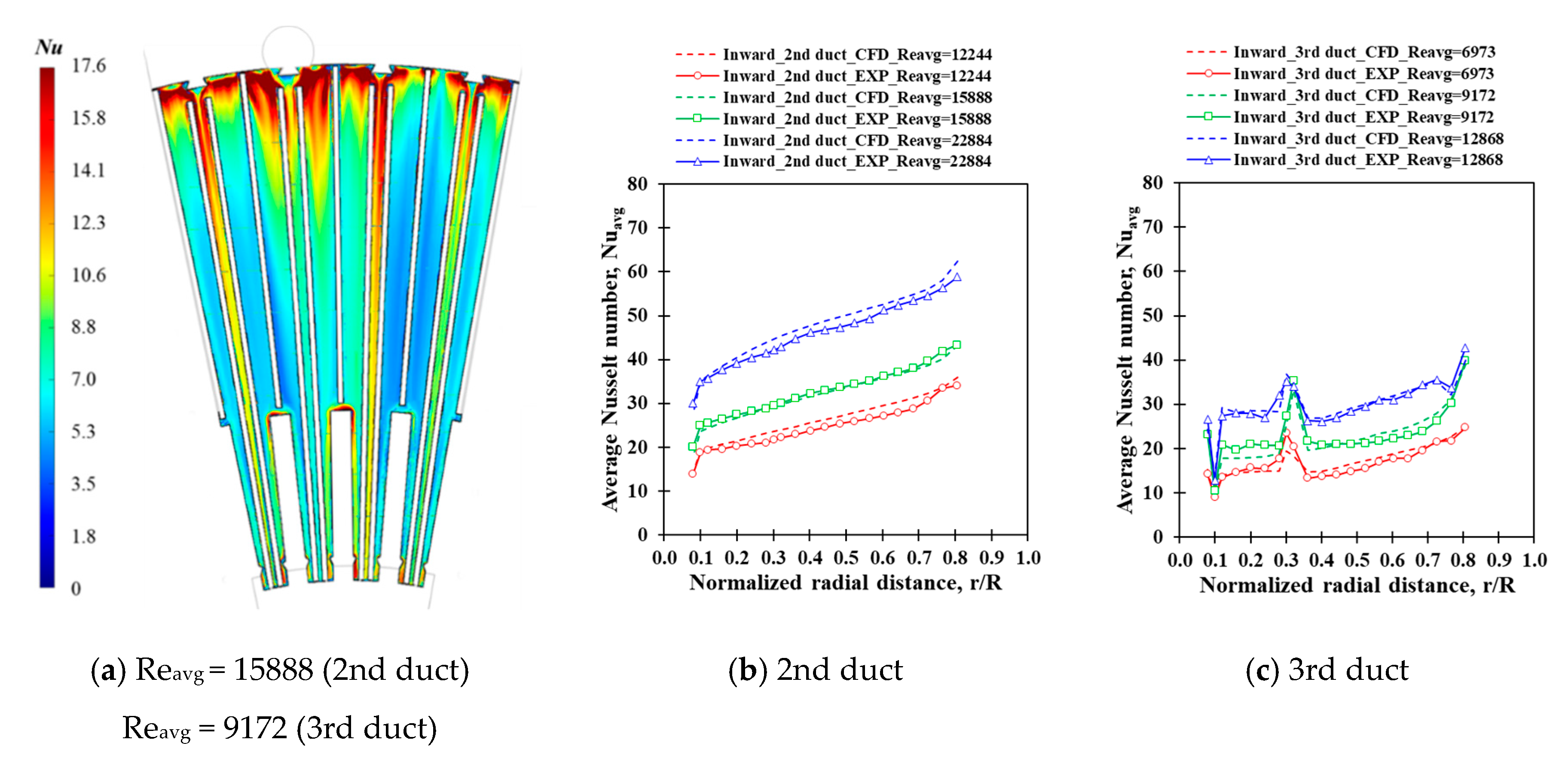
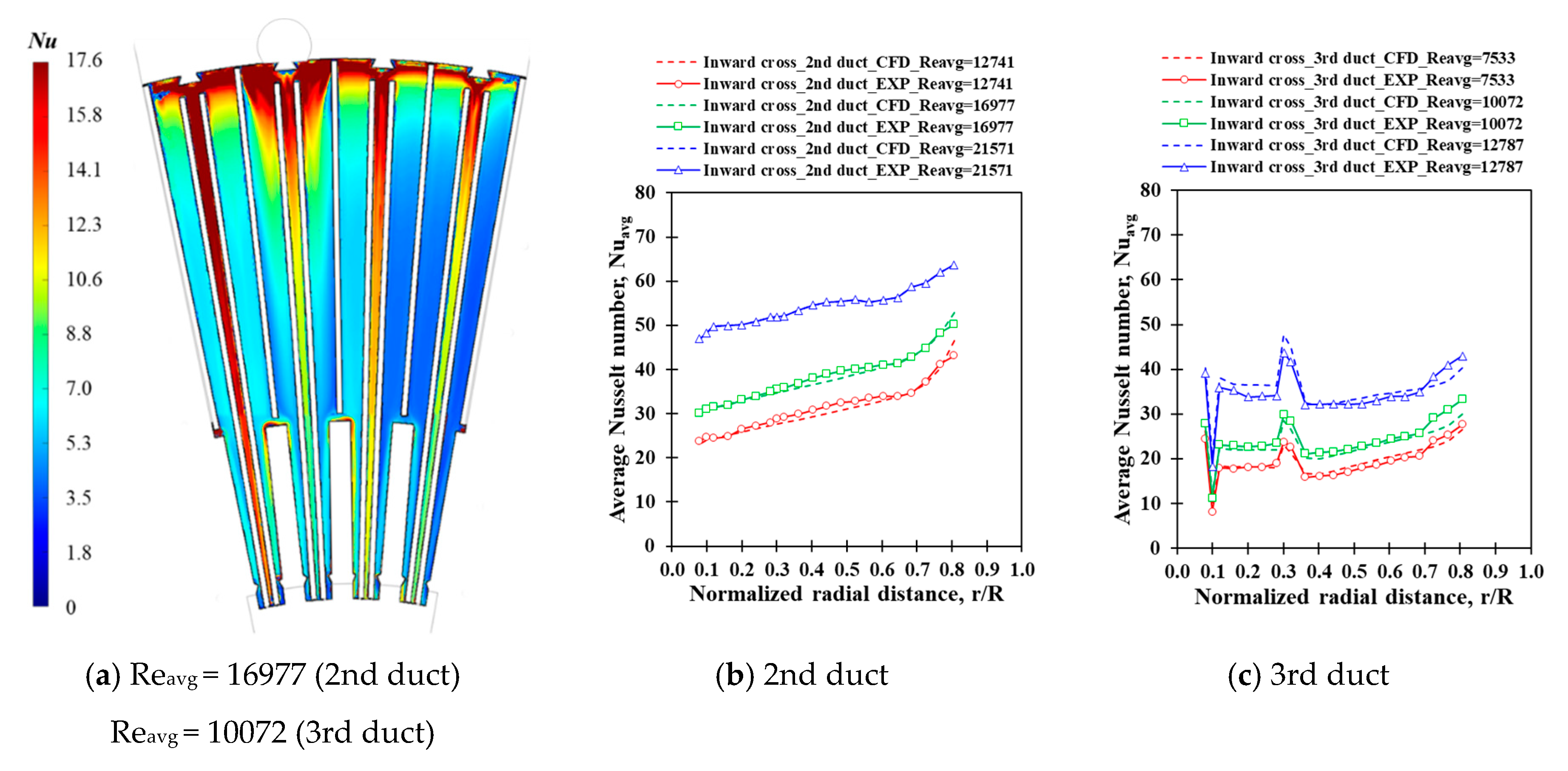
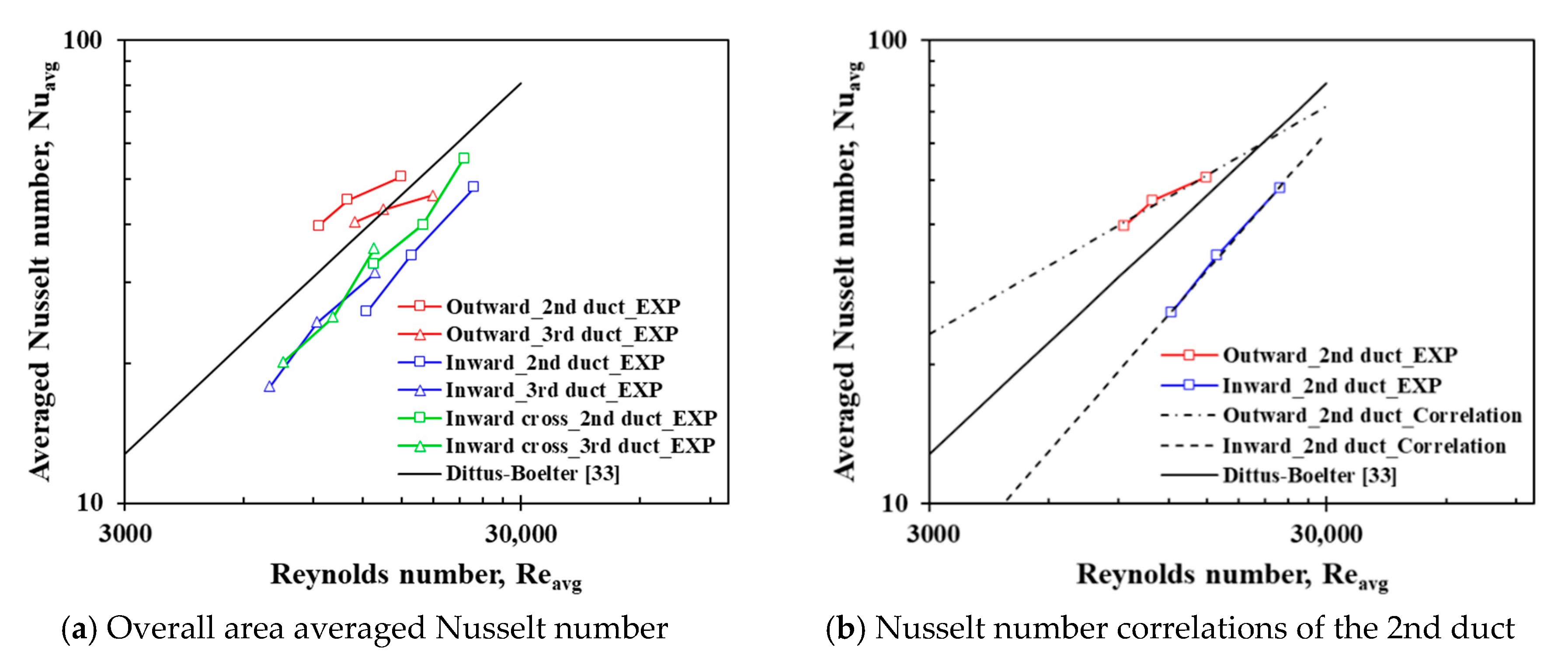
| Model | (1) Outward Flow | (2) Inward Flow | (3) Inward with Cross Flow |
|---|---|---|---|
 | 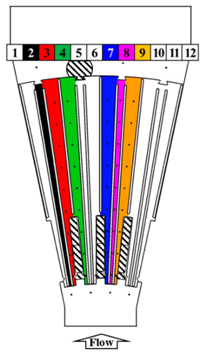 | 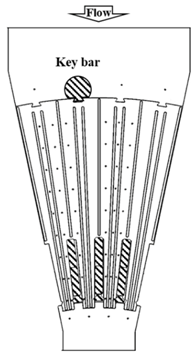 | 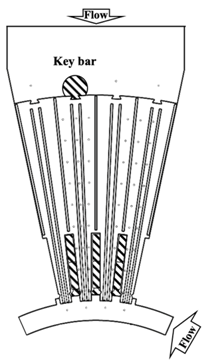 |
| Duct Type | Re | Outward Flow | Inward Flow | Inward with Cross Flow | ||||||
|---|---|---|---|---|---|---|---|---|---|---|
| 2nd duct | Dh | Dh,in = 8.5, Dh,avg = 10.7 (mm) | Dh,in = 12.9, Dh,avg = 10.7 (mm) | Dh,in = 12.9, Dh,avg = 10.7 (mm) | ||||||
| Rein | 11,671 | 13,817 | 18,805 | 10,157 | 13,179 | 18,983 | 10,569 | 14,083 | 17,894 | |
| Reavg | 9273 | 10,978 | 14,941 | 12,244 | 15,888 | 22,884 | 12,741 | 16,977 | 21,571 | |
| 3rd duct | Dh | Dh,in = 9.0, Dh,avg = 13.9 (mm) | Dh,in = 18.8, Dh,avg = 13.9 (mm) | Dh,in = 18.8, Dh,avg = 13.9 (mm) | ||||||
| Rein | 17,602 | 20,807 | 27,774 | 5159 | 6785 | 9520 | 5573 | 7452 | 9460 | |
| Reavg | 11,411 | 13,489 | 18,006 | 6973 | 9172 | 12,868 | 7533 | 10,072 | 12,787 | |
© 2020 by the authors. Licensee MDPI, Basel, Switzerland. This article is an open access article distributed under the terms and conditions of the Creative Commons Attribution (CC BY) license (http://creativecommons.org/licenses/by/4.0/).
Share and Cite
Jeon, S.; Son, C.; Yang, J.; Ha, S.; Hwang, K. Full Surface Heat Transfer Characteristics of Stator Ventilation Duct of a Turbine Generator. Energies 2020, 13, 4137. https://doi.org/10.3390/en13164137
Jeon S, Son C, Yang J, Ha S, Hwang K. Full Surface Heat Transfer Characteristics of Stator Ventilation Duct of a Turbine Generator. Energies. 2020; 13(16):4137. https://doi.org/10.3390/en13164137
Chicago/Turabian StyleJeon, Shinyoung, Changmin Son, Jangsik Yang, Sunghoon Ha, and Kyeha Hwang. 2020. "Full Surface Heat Transfer Characteristics of Stator Ventilation Duct of a Turbine Generator" Energies 13, no. 16: 4137. https://doi.org/10.3390/en13164137
APA StyleJeon, S., Son, C., Yang, J., Ha, S., & Hwang, K. (2020). Full Surface Heat Transfer Characteristics of Stator Ventilation Duct of a Turbine Generator. Energies, 13(16), 4137. https://doi.org/10.3390/en13164137




